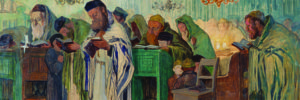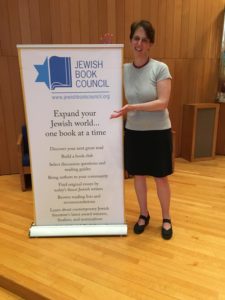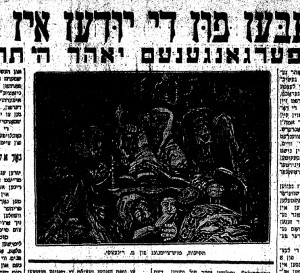My book with jacket arrived this morning on my doorstep! I love the way it looks, particularly the art on the spine ❤️
In bookstores September 6th!
My book with jacket arrived this morning on my doorstep! I love the way it looks, particularly the art on the spine ❤️
In bookstores September 6th!
I recently signed 50 Chasing Portraits bookplates! There’s still time to get yours if you pre-order before August 15th. Details
Hope to see you at a Chasing Portraits book event this fall! Don’t see a venue near you? Stay tuned for the addition of more events! Event Details
The first book review of Chasing Portraits is a starred review from Kirkus!
A page-turning personal history of Rynecki’s search for her great-grandfather’s legacy.
Moshe Rynecki (1881-1943) was a Polish artist whose work “detailed the everyday lives of Polish Jews in the 1920s and 1930s.” His singular oeuvre shows the culture and quotidian activities of his people, and his very identity was intimately tied to his Jewish heritage, even to the point of following them into the Warsaw ghetto. He was an ethnographically inspired painter and thought abstract styles would detract from the world he was portraying. He and his wife, Perla, operated an art supply store—or she did while he painted. By the time of the Nazi invasion in 1939, he had 800 works that needed to be protected. With his son George’s help, he took paintings out of frames, rolled them up, and put them into piles. Moshe also made a list of which pieces went into each pile, but, unfortunately, the list was lost. The works were entrusted to friends to be retrieved after the war. When the Nazis moved the Jews into the ghetto, George refused to take his family, hiding their Jewishness with new identities. Because Moshe would not deny his heritage, he and Perla entered the ghetto. In 1942, George got his mother out, but his father felt that he had to go “where brothers and sisters go. And if it’s death, so be it.” The last they heard was that he was on his way to a death camp. After the war, Perla found a bundle of more than 100 paintings and gave them to her son, who moved to the U.S with his wife. That much of the story is fascinating, but it’s only the beginning, as the author discovers her grandfather’s memoir and begins her search for his paintings.
A wonderful story beautifully told. Rynecki’s yearslong search, successes, frustrations, and failures are a study in perseverance.
Pre-Order Chasing Portraits and get a signed bookplate and bookmark!
Here’s the scoop: If you pre-order the print edition of Chasing Portraits and email a copy of your receipt to ChasingPortraits@gmail.com, I will send you a signed bookplate (it has an adhesive backing) and a cool bookmark!
 Why pre-order? Frankly, because it helps me. Pre-ordered books count towards first week sales numbers which gives the book the best chance of hitting best seller lists. Plus, strong pre-order numbers can inspire my publisher to print more books, which focuses both the publisher and booksellers on the book’s prospects and raises awareness for the documentary. So, if you can pre-order, I’d really appreciate it!
Why pre-order? Frankly, because it helps me. Pre-ordered books count towards first week sales numbers which gives the book the best chance of hitting best seller lists. Plus, strong pre-order numbers can inspire my publisher to print more books, which focuses both the publisher and booksellers on the book’s prospects and raises awareness for the documentary. So, if you can pre-order, I’d really appreciate it!
Where to pre-order? Some retail suggestions: your local independent bookstore, Amazon, Barnes & Noble, Penguin Random House
The fine print: Forward an email receipt or a photo of a paper receipt for the print edition only to ChasingPortraits@gmail.com by August 15, 2016. Be sure to include your mailing address.
Last week I was in New York to pitch the Chasing Portraits book at the Jewish Book Council’s “Meet the Author,” event. The pitch is a 3 day event attended by over 200 authors! I heard fellow authors speak on everything from politics and legal issues to cookbooks, humor, and the Holocaust. This is a very happy me after the 2 minute pitch!
Chasing Portraits is now available for pre-order from your favorite bookseller! It will be in bookstores September 6th.

Read more about the event on JBC’s website.
[thanks to Dina Gold, author of Stolen Legacy, for the photo!]
 Advance praise for Chasing Portraits. Yup, these pretty much just totally and absolutely make my day.
Advance praise for Chasing Portraits. Yup, these pretty much just totally and absolutely make my day.
“Chasing Portraits is a miraculous story of heartbreaking loss and spine-tingling discovery. In her search for her great-grandfather’s paintings, Elizabeth Rynecki becomes a genealogist, an art historian, a detective, a crusader for justice, and a time traveler, peering through windows and into paintings to unearth her family’s past. Her memoir will break your heart, but it will have you cheering wildly too because every new discovery is a triumph of art and love over hatred and loss.”—Amy Stewart, New York Times Bestselling Author of The Drunken Botanist
“A heartfelt, vivid account of a hunt for lost masterpieces painted by a great-grandfather that prove to be unforgettable relics of a rich world swept away by war, taking readers on a lusciously detailed international journey that reminds us that the search for missing paintings is, at heart, a search for missing history.”—Anne-Marie O’Connor, National Bestselling Author of The Lady in Gold
“Elizabeth Rynecki’s Chasing Portraits is part of a gathering wave of stories by the children, grandchildren, and great-grandchildren of Holocaust survivors and Holocaust victims—stories that accept the burden of carrying this legacy forward, with all the anguish, the unanswered questions, and the unexpected joy of recognition this entails. With devotion and determination, Rynecki movingly demonstrates that, even after such unimaginable loss, even seventy years later, fragments of individual lives—and so the untold stories of individuals—can still be recovered . . . if only you keep searching.”—Glenn Kurtz, Author of Three Minutes in Poland
“In recent years, there has been an increase in the awareness of the problem of looted and stolen art, and Chasing Portraits makes an important contribution to the field. But it’s much more than just a tale of detective work. Elizabeth Rynecki’s story is transcendent, presenting the reader with an elevated level of passion and duty. For this reason, it sets itself apart from the rest of the field.”—Anthony M. Amore, Author ofStealing Rembrandts and The Art of the Con
Yesterday afternoon the ARC (Advanced Review Copy…aka a Galley) of Chasing Portraits arrived at my house! It’s a rather indescribable feeling… You write, revise, and edit some more, and then you turn the manuscript into the publisher and lo and behold, the manuscript turns into a book! Needless to say, holding this copy in my hands made my day!
Chasing Portraits, the book, is out September 6th and is available for pre-order.
“And what about the documentary?” you ask. I’ve hired an editor, Tina Nguyen. She’s delightful, fantastic, she understands the story, and she’s now watching the 100+ hours of footage. As for the release date… we need time and a bit more money. I’m writing grants and working on raising the last of the funds. Of course if you’d like to help support the film, donations are always welcome and are much appreciated.
An email arrives. It’s from my friend, Piotr Nazaruk, in Poland. The subject line makes my heart race. It says, “An ink drawing by M. Rynecki.” I’m in the kitchen eating breakfast. It’s early, maybe 6am. I open the email and my phone struggles to download the large PDF. Piotr explains he found the image in the Warsaw Yiddish daily newspaper, Unzer Express from September 25, 1938. “The quality is very low,” he writes. But the Yiddish is clear, it says it’s an India Ink drawing by רינעצקי, the Yiddish spelling of Rynecki.
I walk into my office and boot up my desktop computer to download the image. The black and white image slowly appears. Our internet connection this morning somehow feels throttled. I wonder if the boys are playing too many video games and eating up the bandwidth. Then the image appears, but it’s dark, and I can barely see the people in the painting. 
Piotr tells me he thinks the title is תקיעות = tkija, sound of the ceremonial shofar. “It’s hard to say what is in the painting,” Piotr hedges. “A man blowing a shofar, some books, Torah scrolls?”
I stare at the black and white reprint of the painting in a newspaper published 78 years ago, trying to see something, anything. The top and edges of the image are too dark. I look at the bottom where I think I see two figures, and older man reading a book, and a young man standing(?)/sitting(?) next to him.
“Do you know this one?” Piotr asks.
No, no I do not.
I write to my trusty Yiddish translator, Nick Block. “Can you read this?” I ask. “Does it say it’s my great-grandfather’s?”
“I’m not sure why Piotr is hedging his words so much. It certainly says what he’s translated.” Nick assures me. Then he offers a slightly edited translation of Piotr’s Yiddish. It is plural, “tekies / Tekiot,” he writes. “It means, Sounds of the Shofar or Shofar Blasts.”
I stare at the painting, willing it to become clearer, but for now it’s all I have, another partial clue in a long line of mysteries.
It’s #MuseumWeek 7 days, 7 themes, 7 hashtags. Today’s theme is#architectureMW and it is all about telling the story of a museum’s building, garden, neighborhood or other key locations for the institution. The goal is to introduce the museum from a different point of view. There is, unfortunately, no Moshe Rynecki museum, although his works are in museums in Poland (The Jewish Historical Institute and the National Museum in Warsaw), Israel (Yad Vashem), and the United States (The Magnes Collection of Jewish Art and Life). So I thought I’d riff on the theme a bit and offer images of my great-grandfather’s paintings that incorporate the architecture within the scenes he has painted. Architecture is, after all, also about how people use and interact with interior spaces.